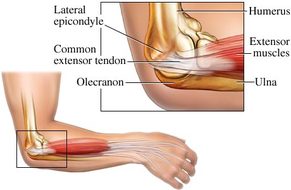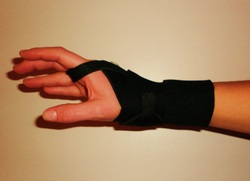What is tennis elbow?
Tennis elbow, or lateral epicondylitis, is a condition characterized by pain and inflammation at the outside of the elbow and frequently the back of the forearm, aggravated by gripping, use of the wrist extensor muscles, and a variety of repetitive activities using the hands.
Tennis elbow, or lateral epicondylitis, is a condition characterized by pain and inflammation at the outside of the elbow and frequently the back of the forearm, aggravated by gripping, use of the wrist extensor muscles, and a variety of repetitive activities using the hands.
The details that your doctor or therapist should explain.

Tennis elbow, or lateral epicondylitis, is a repetitive strain injury of the wrist extensor muscles or their common tendon origin near the elbow. The wrist extensor muscles are on the posterior aspect (the back side) of the forearm. These muscles originate on the lateral epicondyle of the humerus, the bony point at the outside of the elbow, and insert on the back of the wrist and fingers. Pain is usually felt at the lateral epicondyle or the common extensor tendon at the outside of the elbow. Several structures at the outside of the elbow may be painful, but regardless of the pain site, the cause of pain is overworked wrist extensor muscles.
What do the wrist extensor muscles do?
These muscles act to straighten the fingers and/or extend the wrist, moving the knuckles back. During manual tasks like gripping, they act to counter the powerful wrist and finger flexor muscles on the other side of the forearm, keeping the wrist in a functional position. If the wrist extensor muscles did not contract during gripping or other movements that use the finger flexor muscles, the wrist would curl. Instead, the wrist extensors work to put the wrist in its strongest position for gripping. Hand grip is strongest at about 15 degrees of wrist extension. This amount of wrist extension puts the finger flexors at the length where they are strongest. This principle is the length-tension relationship of the muscle, whereby a muscle is strongest at a certain length, and somewhat weaker in its shortest or longest positions. To demonstrate this effect, try making a forceful grip. Notice that during a maximal grip, the wrist extends. This happens to achieve the optimal length-tension relationship for the finger flexors.
Why do the wrist extensors get over-worked?
While diagnosis of tennis elbow itself is easy for a trained professional, the difficult part is understanding why it happened. It is important to have a comprehensive assessment by a skilled manual therapist who has enough time to pay attention to detail. A physiotherapist would be a good place to start.
A common reason for tennis elbow is weakness of the wrist extensor muscles. Combined with repetitive gripping tasks, like using a hammer, or a pinch grip like holding a pen, the wrist extensors get over-worked. The wrist extensor muscles must counteract the wrist flexor muscles during manual tasks, like gripping, typing, hand-writing, holding a glass, or racquet sports. And there needs to be a certain strength ratio between the two muscle groups for normal function. Some sources will cite the optimal ratio at as high as 2:3 (extensors:flexors). In other words, the extensors must be 2/3 the strength of the flexors. Many people who present with tennis elbow have noticeable weakness of the extensor group. On testing, often, we will find strength ratios of 1:5, meaning that the extensors are far too weak. So, every rehabilitation program will involve strengthening the wrist extensors.
This part will surprise you
There are many other factors that can contribute to tennis elbow. These may include neck joint restrictions, neck disc protrusions, shoulder posture, elbow joint restrictions, wrist mobility limitations, acute wrist extensor strains, wrist extensor inflexibility, home or workplace ergonomics, poor technique, and excessive training/work demands. We won't discuss all of these factors in detail. However, the identification and management of these factors in detail is what separates a successful rehabilitation program from one that fails.
Several of the above causes can only be assessed properly by skilled physiotherapists, chiropractors, and osteopaths. Even within these fields there is some variability in techniques acquired and competency. So, look for a therapist that treats tennis elbow regularly and has the qualifications to mobilize or manipulate, or adjust, the neck, elbow and wrist. The therapist should allot sufficient time for a treatment. A typical treatment might consist of assessment, progression of exercises, stretching, massage, myofascial release, elbow or wrist mobilization or manipulation, neck mobilization or manipulation, and discussion about ergonomics, work habits, technique, etc. There should be sufficient time for this in a 20-30 minute session.
The issue of neck treatment is worth discussing a bit further. Many therapists will not look at the neck initially because they lack the skill, or because they know it is time consuming. This component of treatment is the most frequently neglected. Here is why that's a problem. Neck dysfunctions, like joint restrictions, degenerative changes, and disc protrusions, have the ability to put pressure on the spinal cord, facilitating a nerve root segment. This is complicated stuff! But to understand it, you just need to understand that dysfunction in the neck frequently excites nerve root segments that supply the arm. If the nerve is excited, then the muscle it supplies will be excited, or have increased 'tone.' Tone is the resting state of tension in a muscle. If a muscle, like the muscles in the wrist extensor group, have increased tone at all times, it is like they are contracting a bit at all times. So, it is easy to see that a muscle might get over-worked if it is contracting all the time. Fixing the neck problem, can "de-facilitate" the nerve and reduce the resting muscle tone of the wrist extensors. This is why neck treatment is often important in treating tennis elbow.
The wrist and elbow dysfunctions are a bit different. They don't cause neurological facilitation. However, certain joint dysfunctions can change the mechanics of the forearm, so that the wrist extensor muscles are working a little harder during various activities. Again, finding the joint restrictions that deviate from normal and correcting them is often the missing link between a successful rehabilitation program and one that falls short.
In conclusion, find a qualified therapist to help you with your tennis elbow whenever possible.
What do the wrist extensor muscles do?
These muscles act to straighten the fingers and/or extend the wrist, moving the knuckles back. During manual tasks like gripping, they act to counter the powerful wrist and finger flexor muscles on the other side of the forearm, keeping the wrist in a functional position. If the wrist extensor muscles did not contract during gripping or other movements that use the finger flexor muscles, the wrist would curl. Instead, the wrist extensors work to put the wrist in its strongest position for gripping. Hand grip is strongest at about 15 degrees of wrist extension. This amount of wrist extension puts the finger flexors at the length where they are strongest. This principle is the length-tension relationship of the muscle, whereby a muscle is strongest at a certain length, and somewhat weaker in its shortest or longest positions. To demonstrate this effect, try making a forceful grip. Notice that during a maximal grip, the wrist extends. This happens to achieve the optimal length-tension relationship for the finger flexors.
Why do the wrist extensors get over-worked?
While diagnosis of tennis elbow itself is easy for a trained professional, the difficult part is understanding why it happened. It is important to have a comprehensive assessment by a skilled manual therapist who has enough time to pay attention to detail. A physiotherapist would be a good place to start.
A common reason for tennis elbow is weakness of the wrist extensor muscles. Combined with repetitive gripping tasks, like using a hammer, or a pinch grip like holding a pen, the wrist extensors get over-worked. The wrist extensor muscles must counteract the wrist flexor muscles during manual tasks, like gripping, typing, hand-writing, holding a glass, or racquet sports. And there needs to be a certain strength ratio between the two muscle groups for normal function. Some sources will cite the optimal ratio at as high as 2:3 (extensors:flexors). In other words, the extensors must be 2/3 the strength of the flexors. Many people who present with tennis elbow have noticeable weakness of the extensor group. On testing, often, we will find strength ratios of 1:5, meaning that the extensors are far too weak. So, every rehabilitation program will involve strengthening the wrist extensors.
This part will surprise you
There are many other factors that can contribute to tennis elbow. These may include neck joint restrictions, neck disc protrusions, shoulder posture, elbow joint restrictions, wrist mobility limitations, acute wrist extensor strains, wrist extensor inflexibility, home or workplace ergonomics, poor technique, and excessive training/work demands. We won't discuss all of these factors in detail. However, the identification and management of these factors in detail is what separates a successful rehabilitation program from one that fails.
Several of the above causes can only be assessed properly by skilled physiotherapists, chiropractors, and osteopaths. Even within these fields there is some variability in techniques acquired and competency. So, look for a therapist that treats tennis elbow regularly and has the qualifications to mobilize or manipulate, or adjust, the neck, elbow and wrist. The therapist should allot sufficient time for a treatment. A typical treatment might consist of assessment, progression of exercises, stretching, massage, myofascial release, elbow or wrist mobilization or manipulation, neck mobilization or manipulation, and discussion about ergonomics, work habits, technique, etc. There should be sufficient time for this in a 20-30 minute session.
The issue of neck treatment is worth discussing a bit further. Many therapists will not look at the neck initially because they lack the skill, or because they know it is time consuming. This component of treatment is the most frequently neglected. Here is why that's a problem. Neck dysfunctions, like joint restrictions, degenerative changes, and disc protrusions, have the ability to put pressure on the spinal cord, facilitating a nerve root segment. This is complicated stuff! But to understand it, you just need to understand that dysfunction in the neck frequently excites nerve root segments that supply the arm. If the nerve is excited, then the muscle it supplies will be excited, or have increased 'tone.' Tone is the resting state of tension in a muscle. If a muscle, like the muscles in the wrist extensor group, have increased tone at all times, it is like they are contracting a bit at all times. So, it is easy to see that a muscle might get over-worked if it is contracting all the time. Fixing the neck problem, can "de-facilitate" the nerve and reduce the resting muscle tone of the wrist extensors. This is why neck treatment is often important in treating tennis elbow.
The wrist and elbow dysfunctions are a bit different. They don't cause neurological facilitation. However, certain joint dysfunctions can change the mechanics of the forearm, so that the wrist extensor muscles are working a little harder during various activities. Again, finding the joint restrictions that deviate from normal and correcting them is often the missing link between a successful rehabilitation program and one that falls short.
In conclusion, find a qualified therapist to help you with your tennis elbow whenever possible.
Get a Tennis Elbow Wrist Brace!

The "TEWB" is a revolutionary new tennis elbow brace design that actually works! The TEWB is the first tennis elbow brace that addresses the cause of the problem--overworked wrist extensor muscles. By assisting the muscle action of the overworked muscles, the brace provides instant elbow and forearm relief. Put your struggle with tennis elbow behind you. Get one today!
Money back Guarantee!
Order now!
Money back Guarantee!
Order now!
